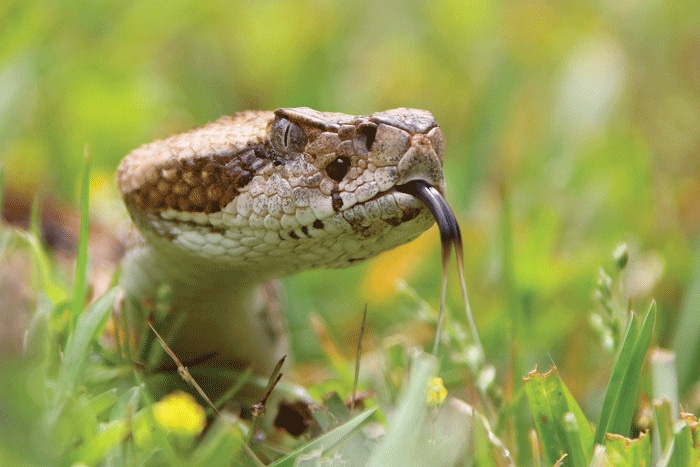April 25, 2013

As one of the most misunderstood reptiles, the snake seems to bear the brunt of man’s fear of nature.
“It all goes back to the Garden of Eden,” I can hear my sweet Southern Baptist mother say. “Snakes are cursed.”
Cursed indeed — but I believe that curse has more to do with man’s chosen ignorance than a God-given stigma regarding one of His most fascinating creations.
These magnificent reptiles roam the woods and water of Alabama searching for food and shelter free of persecution until either we enter their habitat or their search unknowingly brings them into “our space.”
What are we so afraid of? Alabama is home to more than 40 species of snakes, and only six of these are venomous: the eastern coral snake, the eastern cottonmouth, the copperhead, the eastern diamondback rattlesnake, the timber rattlesnake and the pygmy rattlesnake.
What is the solution to our snake trepidation? Learn how to identify the venomous ones, respect their space and enjoy the rest.
The eastern coral snake is so rare and secretive that the odds of an encounter are slim to none. It is a slender-bodied snake with a short head only slightly wider than its neck. Its upper jaw has a pair of immovable fangs with a body pattern consisting of alternating red, yellow and black rings (with red and yellow touching, hence “red on yellow, kill a fellow”) that circle both the back and belly. While this snake is not aggressive, its venom is considered to be the most toxic of any snake in North America.
The five pit vipers are so named for the pit-like depressions between the nostrils and eyes. These serve as heat-seekers, helping the snake locate warm-blooded prey. These snakes also have elliptical pupils and a set of impressive fangs that are capable of injecting venom. In the juvenile stage, most pit vipers possess a yellow-tipped tail that is used as a lure.
One venomous snake encountered in and near the water is the eastern cottonmouth. It is often confused with non-venomous water snakes because of its color pattern, but take a good look at its head. It is thicker and broader than the neck; and when viewed from above, the eyes cannot be seen. As for behavior, it will shake its tail when excited and throw its head upward to reveal its signature “cotton mouth.”
The copperhead is another commonly viewed venomous snake in Alabama. This thick-bodied reptile features a classic copper-colored head that is much wider than its neck. While its body color may vary, the copperhead displays classic, dark, hourglass-shaped cross bands.
Three species of rattlesnakes
As for the infamous rattlesnakes, Alabama hosts three different species: the eastern diamondback rattlesnake, the timber rattlesnake (also called the canebrake rattlesnake), and the pygmy rattlesnake.
The largest of them all, the eastern diamondback, can reach up to seven feet long with a short, stout tail featuring a characteristic rattle at the end. This rattle is a series of hollow, interlocking sections that click against each other when in vibration mode. Yellow diamond shapes and black and brown centers color the snake that also possesses a large head. This snake doesn’t strike without reason. It will remain stationary until it senses a threat or is physically touched. Its defense stance is a coiled position with its head in the center and its rattle upright and vibrating. When it chooses to strike, it can reach up to two-thirds the length of its body.
The timber rattlesnake also showcases a distinct broad head and narrow neck. Its color may be black to yellow to pink to gray with dark bent crossbands along its body. Its short, thick, velvety tail is black with a tan rattle.
The pygmy rattlesnake looks like a miniature version of the other rattlers. Usually less than two feet long, this rattlesnake also has a head that is broader than its body (which can vary in color from gray to tan to lavender to orange to red), and it possesses a tiny rattle that is seldom heard.
Take a little time to identify these six venomous serpents, and share your knowledge with friends and family. The next time you see a snake crossing the road, please don’t go out of your way to run it over. And if you have one hanging around your house, be thankful that it’s consuming any mammals that might otherwise enter your home or mow down your garden.
You just might find that searching for snakes is less fearful and more fun than you imagined.
I am still working on Mama. Thankfully, she isn’t as quick to grab a hoe and chop a snake’s head off as she used to be. Now she just calls for Daddy to “come and get it.” I call that progress.
Want access to the very latest in agriculture news each day? Subscribe to Southeast Farm Press Daily.
You might also like
Livestock producers should expect bright future
Texas growers face third straight year of relentless drought
Input costs top list of cotton grower concerns
Cover crop wheat, horseweed presenting burndown problems
You May Also Like




